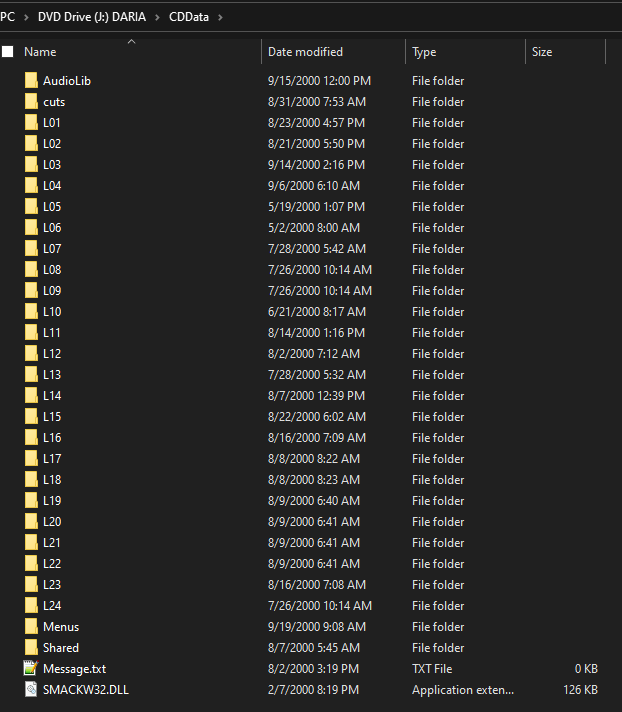Finding the Daria Theme Song in an Old PC Game
- Posted by mariteaux on October 12th, 2020 filed in Modding
- Comment now »
So, Daria. I’ve only ever seen bits and pieces of the show, admittedly (I like what I’ve seen, though), and probably won’t go digging for more unless they restore all the music. I’m a purist sort. (I am aware of that Daria restoration project, though, might be something to look into.) mon loves it though.
One thing that I do quite like is its theme song, the fabled “You’re Standing on My Neck” by Splendora. Sardonic and monotone as the show’s namesake, it’s a lovely musical buzzsaw in a decade full of ’em. As they go over in their retrospective interview with Billboard, though, the Splendora sisters have never been able to release this song properly. It was used as the theme song to one of the most fondly remembered 90s shows, and the full song has never been released, not even on some weird promo disc.
Of course, if you look on YouTube now, you’ll find a bunch of not exactly brilliant quality uploads…of the full song! So where do these come from then?

That, lads, is what I’m here to discuss today. You see, regardless of where each of these uploads came from (and no doubt they’re a few generations down the line, probably thanks to a few dubious MP3 websites), they’re all sourced from a little-known PC game tie-in to Daria called Daria’s Inferno, as the Wikipedia article mentions:
The game is the only media ever to feature the TV series’ entire theme song, “You’re Standing on My Neck” by Splendora, only one verse of which is ever heard on the show.
As I was looking for the best possible quality version of the song for my old little packrat hoard, I decided to go to the Internet Archive, source out a copy of this game myself, and see exactly what I was up against.
Now, PC games, especially older PC games, tend to be just a little hit and miss with their file formats. Naturally, no one uses the same engines, and the file formats are usually not the consumer-grade ones my tools tend to work on. (Granted, exceptions do exist, namely games like GTA: San Andreas that use Vorbis encoding for their radio stations.) You’re pretty much up against either a concerted reverse-engineering effort or pure luck in most cases. (And that’s assuming the files haven’t been encrypted!) This one’s from 2000, so still very much that wild west where anything went as far as audio and video. Still, college try.

The game’s file system is fairly sensible, with all the game data tucked away in the CDData folder. (Slight misnomer: installing the game copies all this to your hard drive.) There’s an AudioLib folder (general dialogue and sound effects), a cuts folder (cutscenes), 24 level folders, a Menus folder, and then a Shared folder (for cursors and things). The level folders aren’t relevant to us because only actual gameplay materials are in them. Even the between-level cutscenes are stored elsewhere.
My first thought was to attack that AudioLib folder, naturally. There’s only a single file in there, an 84mb…DAT file. Who knows what that is. My usual order of business when I need to peek at rogue file formats is to use a hex editor and look for a magic number. Not quite in the file header but a little further down, I found two strings, RIFF and WAVE, RIFF being a file format that defines standard chunks of data. This one’s just PCM audio, thankfully, little endian, 16-bit, so aside from me getting the sample rate wrong (it’s 22khz, not 44.1khz), it imported into Audacity first try.

Unfortunately, no Splendora here. This file contains mostly the game’s dialogue (all 22 minutes of it), incidental music that I can only describe as gay porn music at times, and some sound effects towards the end. Damn.
So I turned my attention to the cuts folder, and this is a little more interesting. If you pay attention to the logos at the start of some games, you might’ve seen a logo for something called Bink Video. Bink is a video codec meant specifically for video games–quick decode, no dependencies. Daria’s Inferno is so old, it actually uses the predecessor to Bink Video–Smacker Video. Smacker Video is among the very first consumer video codecs, originally unveiled in 1994, meant for 8-bit, 256 color video encoding. Thankfully, this means ffmpeg will more than happily take the game’s cutscenes.
Input #0, smk, from 'C:\Users\mariteaux\Desktop\L1END.smk': Duration: 00:00:59.50, start: 0.000000, bitrate: 2687 kb/s Stream #0:0: Video: smackvideo (SMK2 / 0x324B4D53), pal8, 640x480, 12 tbr, 12 tbn, 12 tbc Stream #0:1: Audio: smackaudio (SMKA / 0x414B4D53), 22050 Hz, mono, s16
Admittedly, even on a transcode, the video files actually look pretty good. No clue what Smacker settings they were using, but have a sample.
Now I just had to find which file the song was hiding in. Spoiler alert, credits.smk. You can save yourself some trouble and just drag the Smacker file (or indeed, any ffmpeg-compatible audio file) into the Audacity window, and it’ll load it.
Anyway! Song!
Now, unfortunately, all the audio in the game was encoded at 22khz and in mono, so as far as the music goes, we’re talking maybe cheap junker Type I cassette quality. But honestly, I don’t necessarily mind it? Maybe I’m just too used to listening to shit like this that could only sound worse if it was inaudible, but the big thing you’re missing is the air and cymbals in the recording. I can deal with it. Of course, there’s also a case to be made that punk was just meant to sound this lo-fi.
We can still only hope one day for a proper CD reissue of In the Grass with Splendora’s Daria stuff tacked on as bonus tracks, but this is the best we’ve got for now. Still, neat little mini-adventure! I’m sure there will be other things taking up my week to break out the march of Rediscoverings I’ve got lined up for you all…
